
 Artist Alley is part of most Comic Cons and Expos. As the name suggests, it’s a section for artists and independent creators. Each space is often a single, no-frills table, ideal for smaller budgets or those who fly to shows with only their product and a banner or two.
Artist Alley is part of most Comic Cons and Expos. As the name suggests, it’s a section for artists and independent creators. Each space is often a single, no-frills table, ideal for smaller budgets or those who fly to shows with only their product and a banner or two.
At my first Calgary Expo as a vendor in 2013, that’s where I planned to be. But a vendor I knew talked me into spending a little more money to get a Small Press booth. It had a bit more space and a pipe and drape backdrop between the booths. It was great advice, and I was in Small Press for the first five years.
 This was my first year setup, and I was thrilled I got enough sales to cover my expenses. Shonna helped me out the first couple of years, but I’ve long been able to handle this show solo. She works hard at her own job, so I don’t need her to come and do mine, too.
This was my first year setup, and I was thrilled I got enough sales to cover my expenses. Shonna helped me out the first couple of years, but I’ve long been able to handle this show solo. She works hard at her own job, so I don’t need her to come and do mine, too.
While most of these paintings are retired, a few are still popular today in prints and with licensing clients. Nobody is more surprised than me.
Shonna and I laughed this week, talking about those first years. There were no YouTube videos to tell you how to prepare for a show or what equipment you’d need. There were no pay terminals connected to our phones; it was all cash sales. You had to learn by watching other vendors, looking at their setups, and asking for advice from anybody and everybody.
Fortunately, other vendors had been where I was and freely offered tips, tricks, advice and supplier info. I do my best to pay that generosity forward when newbies ask for help.
The Expo grew yearly, and Artist Alley moved to the Big Four building. As part of that redesign, they eliminated the Small Press section. I had to decide if I wanted to step backward and leave the main building or invest in more space, equipment and inventory and become a retailer with a full-sized 10’x10’ corner booth.
To this day, I still get people asking me why I’m not in Artist Alley. The simplest answer is that I like having more space and professional pipe and drape dividers. An artist in the retail section stands out more than one squeezed in among many others. I also pay an electrical fee each year to power my lights, a service not available in Artist Alley.
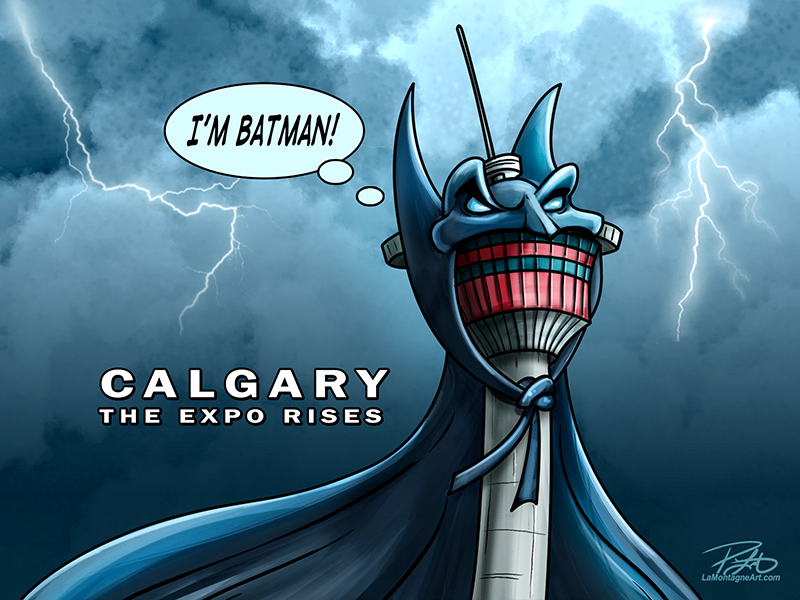 The BMO Centre has been under renovation for several years, and the show’s footprint has kept shifting. With the convention centre expansion and renovation completed this year, it’s a massive change, and Artist Alley is finally back with the rest of the show.
The BMO Centre has been under renovation for several years, and the show’s footprint has kept shifting. With the convention centre expansion and renovation completed this year, it’s a massive change, and Artist Alley is finally back with the rest of the show.
The other day, I chatted with a subscriber who works for a wholesale customer. She’s more involved in the online Expo community than I am and shared that some of the Artist Alley vendors were disappointed or upset that the show is now under one roof.
I understand their fear of change, especially if the divided venue is the only thing they know. They’re likely unaware the show only split when it got too big to contain itself. Putting Artist Alley in the Big Four building was a compromise, and back then, many were upset and disappointed at the split. This year, it’s a welcome reunion for those who remember the good old days.
As this is my tenth year, having experienced both options, I have no doubt that having the whole show back together will be an advantage for vendors and attendees alike. With no requirement to leave one building and enter another, people will spend more time in one place, which means everyone will get to see everything.
I hope the Artist Alley vendors find out it’s probably a good thing for them, and I want them all to do well.
Five days in one location means you can get to know your neighbours during the slower periods and before opening each day. I always learn something from other vendors, even if they’re new. I’ve had mostly good neighbours in my ten years of Expos, but occasional challenges have occurred.
Two years ago, a collective of three or four young women selling their costume jewelry had boundary issues. They pushed into my booth several times, threatening to knock my art off the walls. They hung out in front of or IN my booth with their friends, or they cranked up their club music, making it difficult to talk with my customers.
Last year, however, I was next to a couple of young guys from Grande Prairie who were friendly and fun to be around. They politely asked if they could hang a banner off my grid wall on their side, and I was happy to accommodate them.
 This was my booth in 2019, one of my best spots ever. During setup, the booth next to me was a no-show, and the vendor on the other side of the gap asked the organizers if he could take some of that space. They agreed. He excitedly came to me and said he’d only take half of it, and I could have the other half, a generous gesture on his part. We both expanded our booths and even had storage space between us.
This was my booth in 2019, one of my best spots ever. During setup, the booth next to me was a no-show, and the vendor on the other side of the gap asked the organizers if he could take some of that space. They agreed. He excitedly came to me and said he’d only take half of it, and I could have the other half, a generous gesture on his part. We both expanded our booths and even had storage space between us.
Another reason I loved this spot was that it was next to one of the widest aisles beside a wall and a straight line to one of the loading doors. On teardown, it was pouring rain that year. The vendors around me cleared out quickly. After I packed everything and it was time to load out, one of the show staff offered to let me bring my car inside. I parked beside my booth, loaded up comfortably, and drove out the door.
This was likely the only time that will ever happen at this show, but it sure was a treat.
The most familiar faces at the Expo are my wonderful subscribers, customers and collectors who come back year after year to support my work. I see several of the same vendors, too, but I only know a few. It’s a busy show, with 100,000 people attending over four days, so spending time outside my vendor neighbourhood is impossible.
One vendor I know has been at this show for about as long as I have. Brock is a talented scroll saw artist with pop culture and entertainment-themed work that fits this audience perfectly. We chat each day of the show, before opening, or when he and his family come by my booth to get some new prints and stickers.
Because I’m usually at the show by myself, they’ve always been so kind to offer to watch my booth if I need a bathroom break. Several of my long-time collector friends do that, too, and it’s greatly appreciated. I bring my food, so that’s the only time I need to leave my space.
This week, the Expo updated its Exhibitor List to reveal booth numbers. I was delighted to discover that, for the first time, Brock and I are next-door neighbours, our corner booths forming the end of an aisle block. What a great start to the event.
 Though everything I need for Expo is here and mostly ready, I’m still working on last-minute prep and drawing editorial cartoons to keep my newspaper clients supplied while I’m away. The Monday after the show is Election Day in Canada, so I must also have that morning’s cartoon done in advance.
Though everything I need for Expo is here and mostly ready, I’m still working on last-minute prep and drawing editorial cartoons to keep my newspaper clients supplied while I’m away. The Monday after the show is Election Day in Canada, so I must also have that morning’s cartoon done in advance.
To you diehards who attend every year, I look forward to seeing your smiling faces once again.
If this will be your first Calgary Expo, please stop by and say Hello. I love seeing the shell-shocked expressions on people who have never been to this circus. You’re in for a real treat.
Cheers,
Patrick

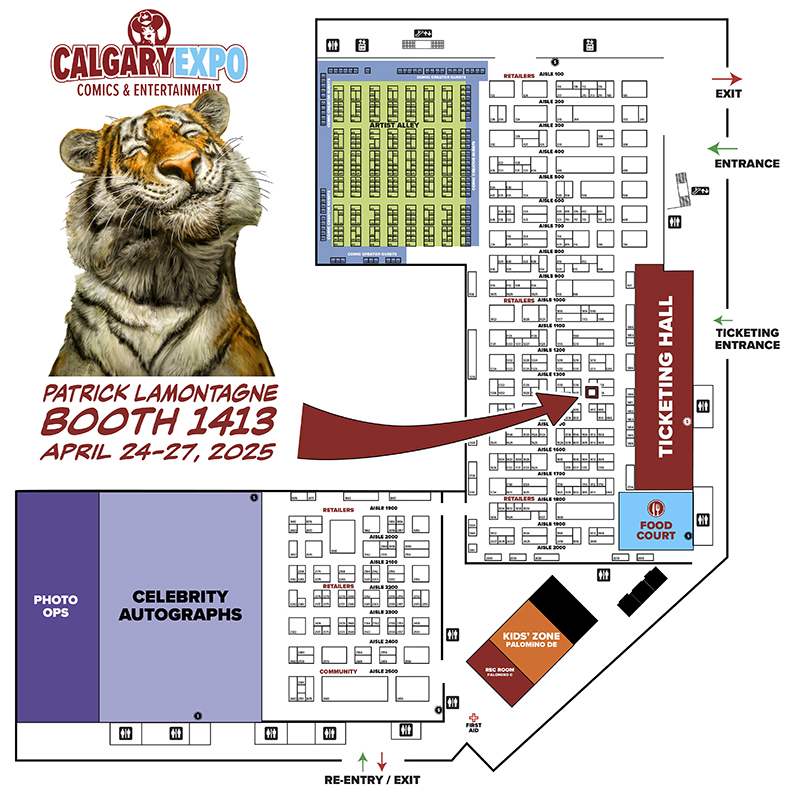


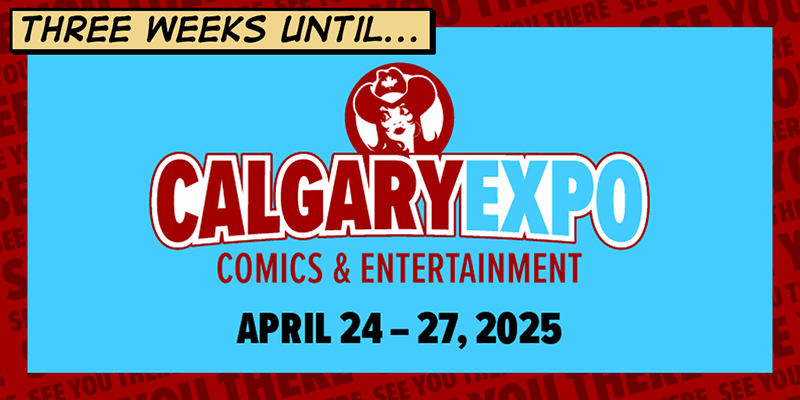
 Fortunately, everything I need for Expo is already here or on the way. I placed a large print order earlier this week to fill orders for
Fortunately, everything I need for Expo is already here or on the way. I placed a large print order earlier this week to fill orders for 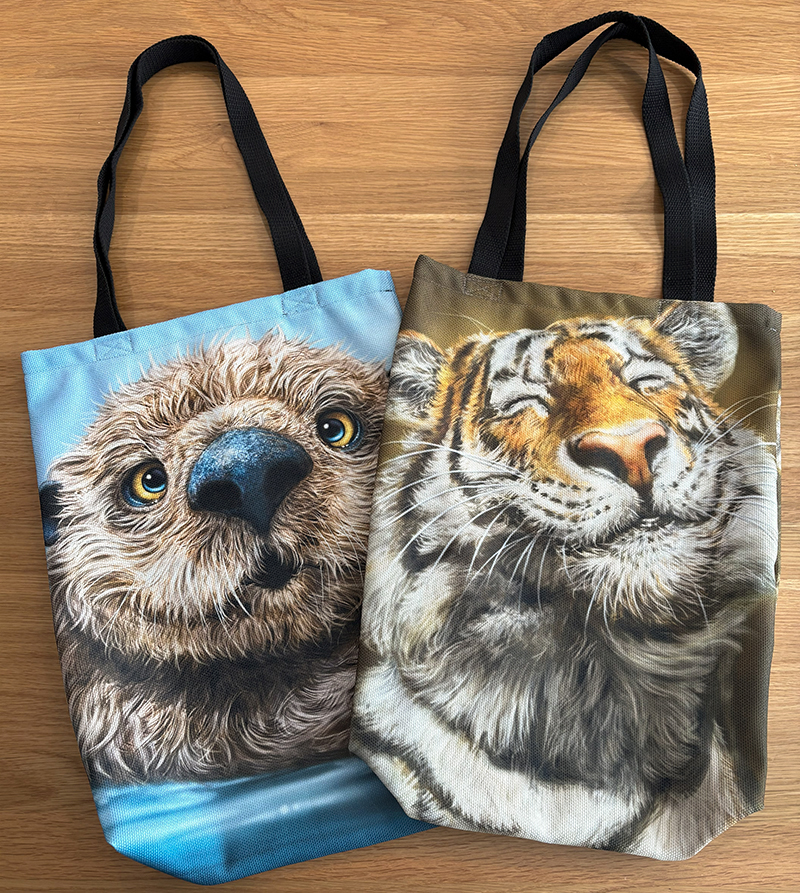 Additionally, the next three weeks will be some of the busiest of my year, and the bags won’t even be here for another week. I don’t have the room to add hours and days of shipping and delivering tote bag orders on top of all the prep and drawing cartoons.
Additionally, the next three weeks will be some of the busiest of my year, and the bags won’t even be here for another week. I don’t have the room to add hours and days of shipping and delivering tote bag orders on top of all the prep and drawing cartoons. But every year, even if they follow
But every year, even if they follow 







 In 1998, while managing a waterslide facility at a hotel in Banff, I drew my first cartoon for the Banff Crag & Canyon. Many editorial cartoonists get into the profession because they’re political junkies who can draw. I liked to draw, and I figured I could learn to follow the news and politics if I had to.
In 1998, while managing a waterslide facility at a hotel in Banff, I drew my first cartoon for the Banff Crag & Canyon. Many editorial cartoonists get into the profession because they’re political junkies who can draw. I liked to draw, and I figured I could learn to follow the news and politics if I had to.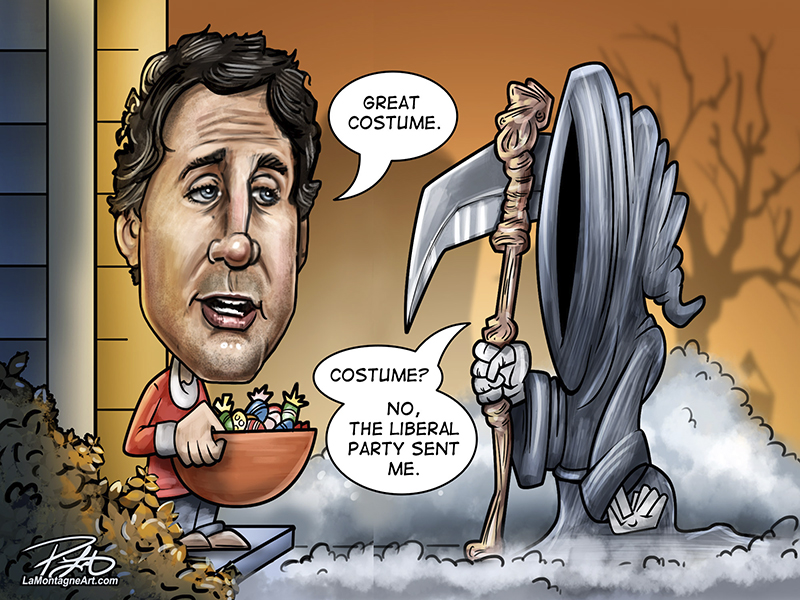 So, what’s a syndicated cartoon? I get that question a lot.
So, what’s a syndicated cartoon? I get that question a lot. I’m most proud of the awards I received at Photoshop World Las Vegas in 2010 and 2014. The first year, I won the Illustration and Best in Show awards for some of my early animal paintings. That recognition was important to me because it was from an organization full of people I liked and respected. They were an encouraging group of talented artists and teachers, and they helped me become a better artist.
I’m most proud of the awards I received at Photoshop World Las Vegas in 2010 and 2014. The first year, I won the Illustration and Best in Show awards for some of my early animal paintings. That recognition was important to me because it was from an organization full of people I liked and respected. They were an encouraging group of talented artists and teachers, and they helped me become a better artist. The
The  I’ve got some mixed feelings about this unexpected nomination. I’m pleased at the recognition, of course. It’s a bit of validation in a profession where I’ve often felt like an outsider.
I’ve got some mixed feelings about this unexpected nomination. I’m pleased at the recognition, of course. It’s a bit of validation in a profession where I’ve often felt like an outsider. When I finished this Ringleader painting,
When I finished this Ringleader painting,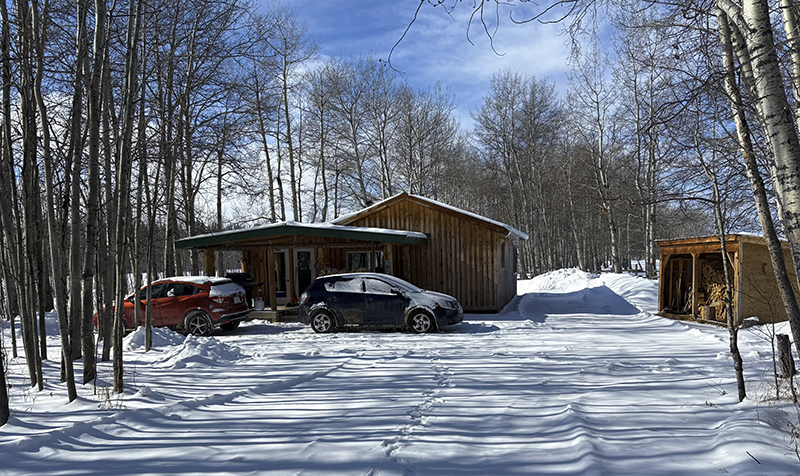 There was still plenty of snow on the ground, on the colder side of March, and we didn’t see any wildlife. But we did what greying old men like us usually do; played cards and games, went for walks around the property, napped and played guitar. This was a selfie I took for a text reply to Shonna one afternoon when she asked how we were doing.
There was still plenty of snow on the ground, on the colder side of March, and we didn’t see any wildlife. But we did what greying old men like us usually do; played cards and games, went for walks around the property, napped and played guitar. This was a selfie I took for a text reply to Shonna one afternoon when she asked how we were doing. She complimented our usual black T-shirt matching ensembles. I told her I suspected she might be making fun of us, to which she replied, “Nailed it!”
She complimented our usual black T-shirt matching ensembles. I told her I suspected she might be making fun of us, to which she replied, “Nailed it!”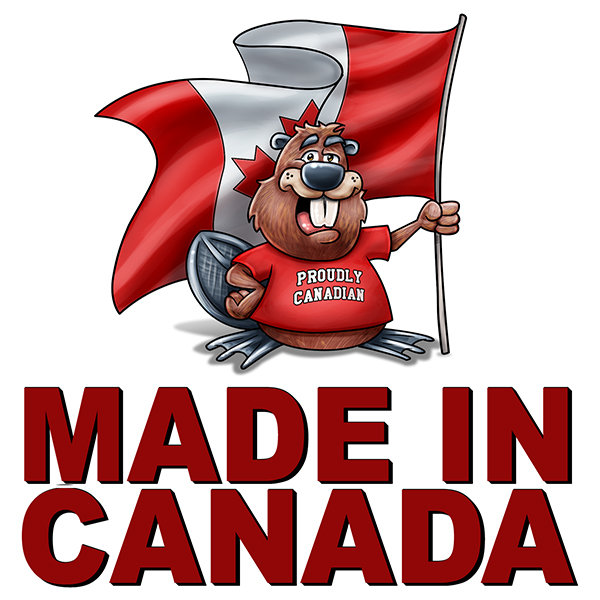
 Canadians aren’t happy.
Canadians aren’t happy.



 I have always strived for Made in Canada with the products I sell.
I have always strived for Made in Canada with the products I sell.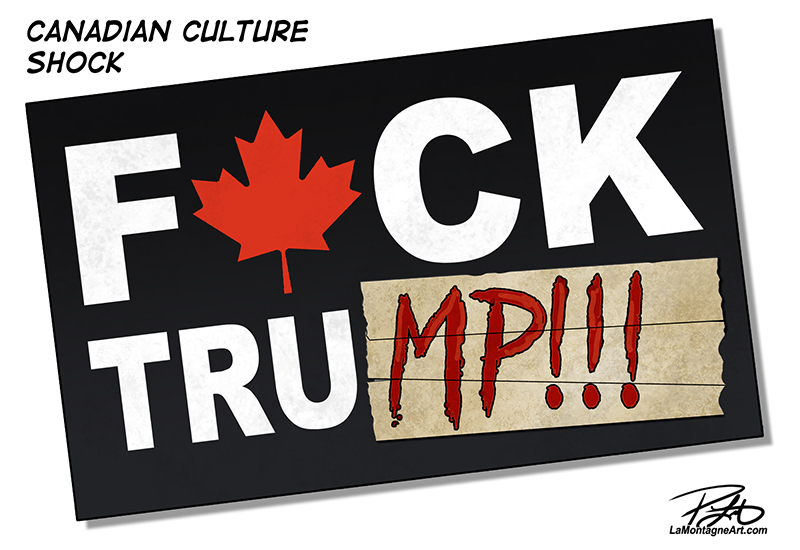
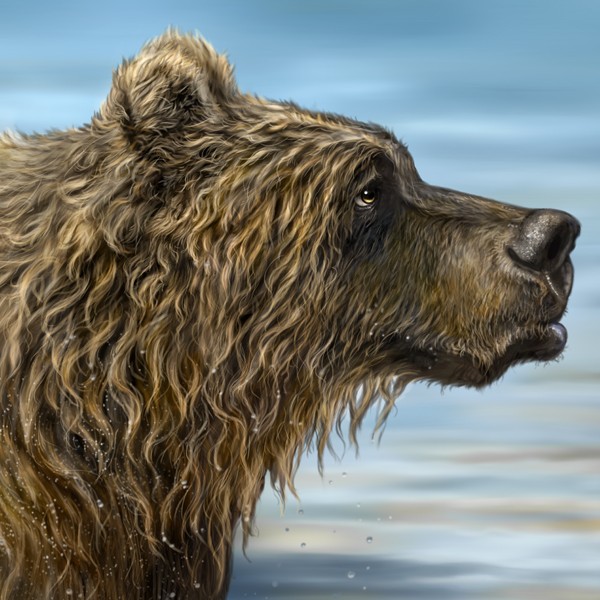
 First, here’s a painting I just finished yesterday called Pouty Bear. Even though most of the animals I paint are smiling and happy, I occasionally change them up, even if I know that a different expression may not appeal to people.
First, here’s a painting I just finished yesterday called Pouty Bear. Even though most of the animals I paint are smiling and happy, I occasionally change them up, even if I know that a different expression may not appeal to people. Commissions and Comic-Con
Commissions and Comic-Con

 Several people emailed me asking if I’ll have them in the
Several people emailed me asking if I’ll have them in the  But I’d love to hear your thoughts.
But I’d love to hear your thoughts.
 Rich and Jill have been coming to the Bow Valley from their home in the UK every year for over a decade. While I don’t remember our first encounter in 2010, I had delivered an out-of-stock print of my first wolf painting to them at the Two Wolves gallery in Canmore.
Rich and Jill have been coming to the Bow Valley from their home in the UK every year for over a decade. While I don’t remember our first encounter in 2010, I had delivered an out-of-stock print of my first wolf painting to them at the Two Wolves gallery in Canmore.
 I met them at a local brewery for a drink to deliver their order this weekend. We haven’t had time for anything more than a short exchange on previous deliveries due to weather or distancing during the pandemic, so it was nice to sit and chat with them.
I met them at a local brewery for a drink to deliver their order this weekend. We haven’t had time for anything more than a short exchange on previous deliveries due to weather or distancing during the pandemic, so it was nice to sit and chat with them.

 But it had received a positive response, and a few people sent me emails asking if I would finish it. So, over the last week, I put the time in to complete it, and I think Polar Plunge will be a nice addition to my print releases for spring.
But it had received a positive response, and a few people sent me emails asking if I would finish it. So, over the last week, I put the time in to complete it, and I think Polar Plunge will be a nice addition to my print releases for spring. Last week, I delivered the year’s first print and sticker order to the
Last week, I delivered the year’s first print and sticker order to the  Porcupines are nocturnal, so they’re not active during the day, but like any animal, they’ll make an effort when food is involved. Because Kayla was inside the enclosure, feeding the cute and prickly resident, we had a nice chat while I got some decent reference shots. Add those to the ones I’ve taken at
Porcupines are nocturnal, so they’re not active during the day, but like any animal, they’ll make an effort when food is involved. Because Kayla was inside the enclosure, feeding the cute and prickly resident, we had a nice chat while I got some decent reference shots. Add those to the ones I’ve taken at 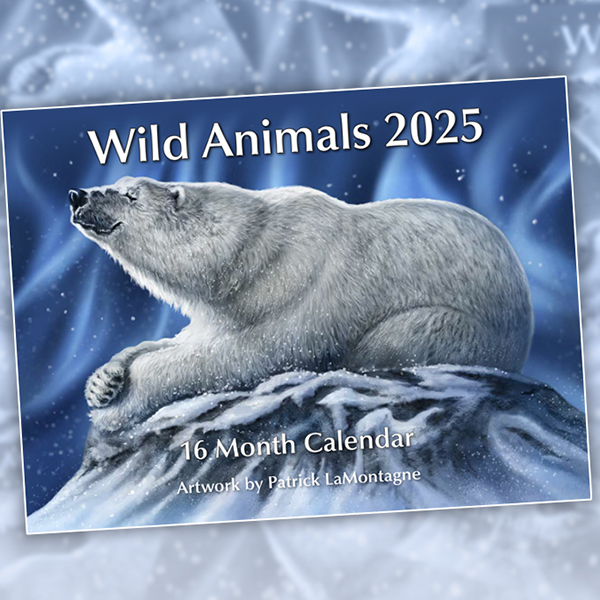
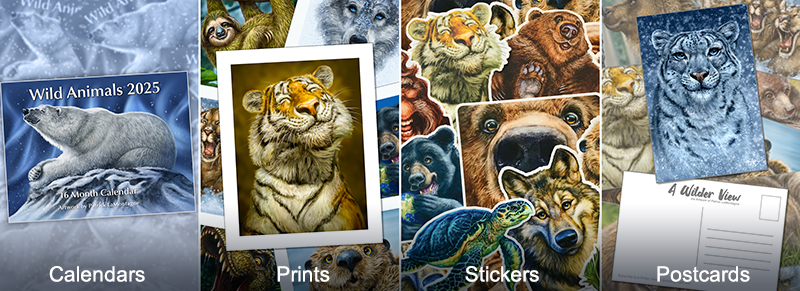



 They do sell, however. I had one woman in Canmore send me an email after the market one Saturday night, regretting she didn’t buy the 16”X16” metal print of my Blue Beak Raven.
They do sell, however. I had one woman in Canmore send me an email after the market one Saturday night, regretting she didn’t buy the 16”X16” metal print of my Blue Beak Raven. Another gentleman wanted the same size Spa Day painting on metal I had in the booth, plus a 12”X16” metal print of my Genial Grizzly I didn’t have. I said I could order and deliver the missing one to him, but he didn’t want to carry the other one around. He asked if he could pay for them, and I could order and drop both of them off in Canmore when they arrived. He wasn’t in a rush, and I was happy to accommodate.
Another gentleman wanted the same size Spa Day painting on metal I had in the booth, plus a 12”X16” metal print of my Genial Grizzly I didn’t have. I said I could order and deliver the missing one to him, but he didn’t want to carry the other one around. He asked if he could pay for them, and I could order and drop both of them off in Canmore when they arrived. He wasn’t in a rush, and I was happy to accommodate. I wanted to sell the metal and canvas prints, but I didn’t want to lose Spa Day on the wall because it attracts a lot of attention. It has become a bestseller, and the metal prints on the wall sell the poster prints on the tables.
I wanted to sell the metal and canvas prints, but I didn’t want to lose Spa Day on the wall because it attracts a lot of attention. It has become a bestseller, and the metal prints on the wall sell the poster prints on the tables. Prepare as I might; what’s true one day might not be the next. Last year, I had two metal prints of my Peanuts painting, one of my personal favourites. It doesn’t work as a poster print because it’s a square composition, so it’s only available in metal or canvas. This year, I made sure to have two metal prints on hand, and I sold them both the first weekend. So, I ordered three more for the last two weekends.
Prepare as I might; what’s true one day might not be the next. Last year, I had two metal prints of my Peanuts painting, one of my personal favourites. It doesn’t work as a poster print because it’s a square composition, so it’s only available in metal or canvas. This year, I made sure to have two metal prints on hand, and I sold them both the first weekend. So, I ordered three more for the last two weekends. I had two metal prints of my Raven on White painting and two of my Highland Cows. I sold one of each the first weekend, so I figured I should get spares.
I had two metal prints of my Raven on White painting and two of my Highland Cows. I sold one of each the first weekend, so I figured I should get spares. But the Highland Cow on the wall sold many poster prints over four weeks, more than any other image. The Raven on White print was also a bestseller.
But the Highland Cow on the wall sold many poster prints over four weeks, more than any other image. The Raven on White print was also a bestseller.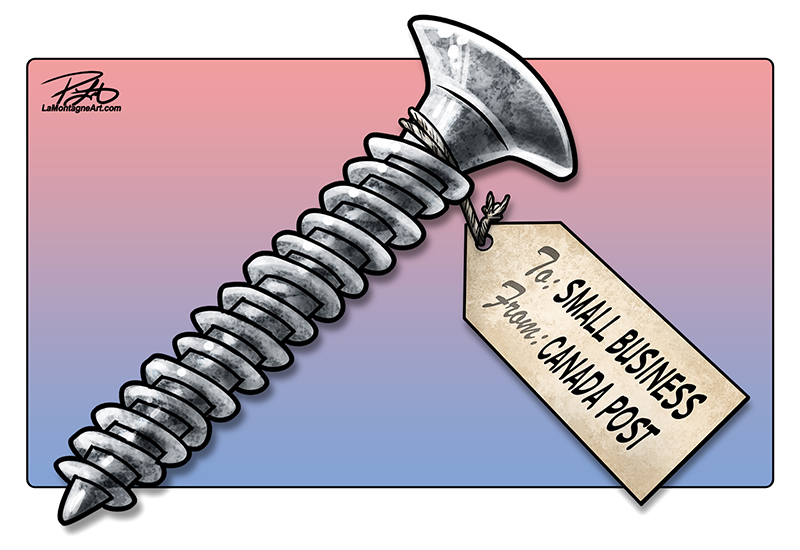
 I had made sure to get my flu and COVID boosters before the markets, but still ‘got sick,’ knocked on my ass by a cold in between Weekends 2 and 3. If you wonder where I get my cartoon ideas, life inspires art. But just like everybody else who gambles with seasonal viruses, I handled it. Inconvenient, uncomfortable, but manageable. And though I began that third weekend still suffering and wearing a mask for a day, it was my second-best sales weekend.
I had made sure to get my flu and COVID boosters before the markets, but still ‘got sick,’ knocked on my ass by a cold in between Weekends 2 and 3. If you wonder where I get my cartoon ideas, life inspires art. But just like everybody else who gambles with seasonal viruses, I handled it. Inconvenient, uncomfortable, but manageable. And though I began that third weekend still suffering and wearing a mask for a day, it was my second-best sales weekend. I regret I have no decent photos of my booth. The bright light on the artwork looks great in person, but my older iPhone camera just can’t seem to compensate correctly, even with an accessory filter. It’s no doubt a user problem.
I regret I have no decent photos of my booth. The bright light on the artwork looks great in person, but my older iPhone camera just can’t seem to compensate correctly, even with an accessory filter. It’s no doubt a user problem.

 Last week was a challenge.
Last week was a challenge. I never know which paintings will become popular and which ones won’t resonate with people. Or sometimes people will like an image, just not as a print to hang on their wall. The only way to find out is to create the painting, release it, and see what happens. When I retire an image in print, it means it will no longer be available on my site or at markets.
I never know which paintings will become popular and which ones won’t resonate with people. Or sometimes people will like an image, just not as a print to hang on their wall. The only way to find out is to create the painting, release it, and see what happens. When I retire an image in print, it means it will no longer be available on my site or at markets. Sometimes, a print will become popular for a particular venue, like the
Sometimes, a print will become popular for a particular venue, like the  My Sasquatch painting is a popular licensed image for Pacific Music & Art, as they have customers all over the Pacific Northwest, BC, and Alaska.
My Sasquatch painting is a popular licensed image for Pacific Music & Art, as they have customers all over the Pacific Northwest, BC, and Alaska. 
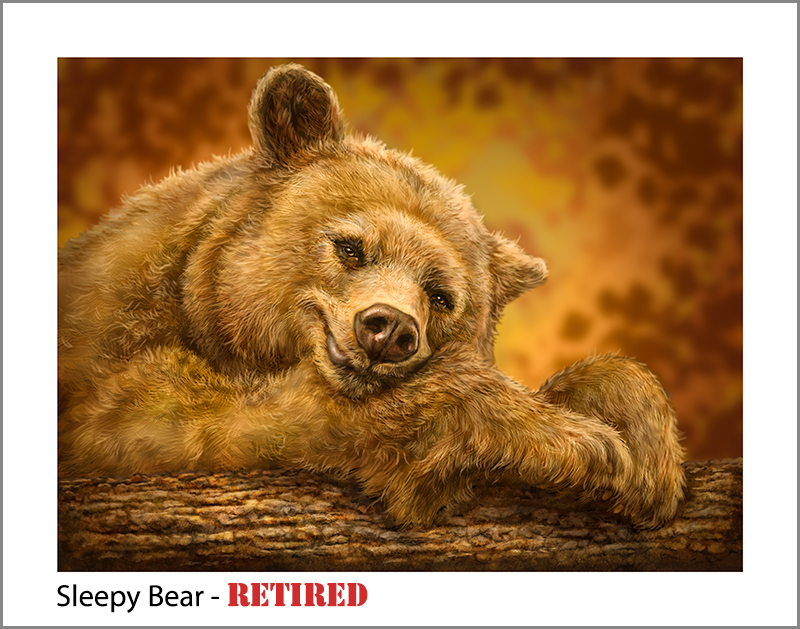
 Even when I no longer sell a print, my licensing clients may still offer the image on their products, and my wholesale customers may still order prints from me to sell to their customers. I just have to require the same minimum orders from them that my printer requires from me.
Even when I no longer sell a print, my licensing clients may still offer the image on their products, and my wholesale customers may still order prints from me to sell to their customers. I just have to require the same minimum orders from them that my printer requires from me. My next-door neighbours,
My next-door neighbours, 